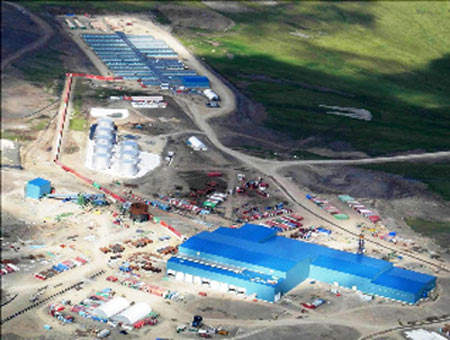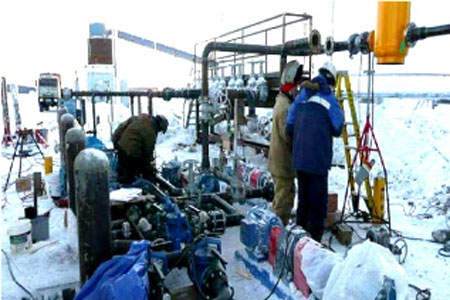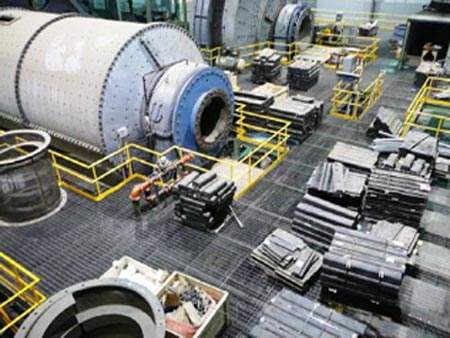In mid-2008, Kinross Gold Corp of Canada announced it was on track to start production at its Kupol project in the Chukotka region, in the Far East of the Russian Federation, It has been mining ore at the site since 2007 and has a stockpile of about 250,000t ready for processing.
The $705m project consists of a high-grade gold and silver vein that remains open along strike. Development of the ore body will use open-pit as well as underground mining methods.
Kinross took over the Kupol project in February 2007 when it acquired Bema Gold Corporation and its 75% interest in it; the other 25% is owned by the Chukotka government. In December 2005, Bema signed loan agreements for up to $425m to finance the construction of the mine. The loans consisted of a project loan for up to $400m and a corporate loan of $25m.
The project loan consisted of two tranches. The first was for $250m and was underwritten in full by Bayerische Hypo und Vereinsbank AG and Société Générale Corporate & Investment Banking. The second tranche, for $150m, came from a group of multilateral and industry finance institutions, of which the Mandated Lead Arrangers consisted of Caterpillar Financial SARL, Export Development Canada, International Finance Corporation and Mitsubishi Corporation.
As part of the project equity contribution, Bema and the Chukotka government signed a subordinated loan for Kupol with the IFC for $25m. Bema’s remaining equity contribution to the project was about $53m and the Chukotka government contributed about $18m of equity. Bema’s equity was funded from a portion of the $120m equity financing it completed in October 2005.
The production at Kupol mine was started during the second half of 2008. During the second half of 2009, Kupol mine reported production of 234,265 gold equivalent ounces. Out of this, Kinross has produced 75% or 175,699 gold equivalent ounces. The production includes 151,327 ounces of gold and 1,633,673 ounces of silver.
Kinross says that, with a cost of sales of about $205 per ounce on a co-product basis using a gold price of $400/oz and a silver price of $6/oz, Kupol will become one of the lowest-cost gold and silver mines in the world.
Geology
The Kupol mine is situated in the Cretaceous Okhotsk-Chukotka volcanogenic belt, in the north-western part of the Anadyr foothills on the boundary between the Anadyr and Bilibino regions in the Chukotka Autonomous Region. The property is underlain by a bimodal sequence of shallow dipping andesite and andesite-basalt flows and pyroclastic units, rhyolite dykes and flow dome complexes.
Two principal mineralised systems have been identified. The bulk of the mineralisation is hosted in a north-south trending dilatant splay off a large regional fault structure of similar orientation. The main deposit consists of one or more polyphase quartz-adularia veins of an epithermal low sulphidation character that are sporadically cut by rhyolite dykes.
Gold and silver mineralisation is primarily associated with sulphosalt-rich bands and pods within colloform, crustiform and brecciated veins
Probable mineral reserves total 8,225,200t, consisting of 4,446,000oz of gold at an average grade of 16.8g/t, and 54,226,000oz of silver at an average grade of 205g/t. In addition, the project contains an inferred resource of 3.9Mt at 13.7g/t gold and 177g/t silver, equating to 1.7Moz of gold and 22.2Moz of silver.
The open pit will be mined as a standard truck/loader operation, with the crusher located at the processing plant and the waste dump located about 2km from the tailings impoundment. Loaders will be used for loading a high percentage of the ore, and excavators will be used for ore-grade control in the pit.
Underground, permafrost exists to a depth of at least 250m, well below the depth of the feasibility mine plan.
Doré production started in 2008, and the mine is expected to produce about 225t of the dore production a year, or an average of 413,000oz Au equivalent annually (Kinross’ share) over the initial 6.5 years of mine life. In 2007, the open pit started delivering 1.42Mt to mill and stockpile over a mine life of four years at an average grade of 20.4g/t gold and 193g/t silver, or 17% of the total project. Also in 2007, the underground started delivering 6.8Mt over a mine life of about ten years at a grade of 16.1g/t gold and 205g/t silver. Silver grade and recovery rate at the mine was 299.35 g/t and 81% by the end of second quarter 2009.
The production schedule has the open pit and underground mines operating at the same time. The Kupol deposit has not yet been fully explored, so additions to the mine life and mineral reserves are possible.
Processing
The Kupol mill is a conventional gold/silver cyanidation plant that incorporates a CCD thickener washing circuit and Merrill-Crowe zinc precipitation because of the high silver ore grade. Cyanide destruction is accomplished with calcium hypochlorite.
The Kupol mill is designed to process about 3,000t of ore per day (1,100,000t per year). Run-of-mine ore is crushed in a jaw crusher and conveyed to a crushed ore storage bin. The crushed ore is ground in a SAG grinding mill followed by a ball mill. Gravity separation of free gold and silver will be carried out with a Knelson concentrator in the grinding circuit.
The ground ore reports to a surge tank. Surge tank discharge is thickened and the thickener underflow is pumped to a pre-aeration tank to passivate sulphide minerals.
Pre-aerated slurry flows by gravity to the cyanide leach circuit to dissolve gold and silver from the ore particles. Leach slurry is pumped to a series of counter-current decantation (CCD) thickeners that wash and recover the dissolved gold and silver values from the leach residue particles.
The pregnant solution produced in the CCD circuit is directed to the Merrill-Crowe circuit where the solution is first clarified in pressure filters, then deaerated with vacuum in a packed tower, followed by precipitation of gold and silver from solution.
The gold/silver precipitate is dried in an oven, mixed with fluxes and then smelted in induction furnaces to produce gold/silver doré bars for shipment to an outside refinery.
Water requirements at Kupol facilities are estimated at about 400,000 to 600,000m³/yr for process water, and 35,000 to 50,000m³/yr for potable water, so a supply has been developed from alluvial deposits in a creek about 4km downstream from the mine. For electrical power, the installed generating capacity is about 25MW with an anticipated demand of 15.5MW using eight generating units. A waste heat system will recover the equivalent of about 15MW, and this will be used to heat the mill building complex and camp facility.
The Kupol property is about 300km from the nearest town, Bilibino, so the camp has been designed as a ‘Permanent Camp’. Its size has been established at 606 people nominal but can be comfortably expanded to 656 people. The living quarters include VIP units, single-occupancy rooms, double-occupancy rooms and senior staff quarters. Because of the extreme weather conditions at Kupol, the camp also has recreational facilities for use after work such as games rooms, a gymnasium and exercise room.
Logistics
Although the site is connected to Bilibino via a network of roads, they are passable only between mid-December and mid-April. During the spring thaw and summer, the Kupol area is accessible only by helicopter – a 1.5-hour flight from Bilibino.
Most supplies will be delivered to the port of Pevek during the summer. The port is on the East Siberian Sea and is typically accessible from July until mid-September.
Supplies and fuel will then be transported to the site using all-wheel, all-terrain vehicles. A trip to and from the Kupol site in supply trucks takes about three days.
Supplies will also be brought to Kupol on a regular basis by fixed-wing aircraft to an airstrip being built about 10km north of the mine.
The project will be managed by Bema Gold Corporation and uses a delivery method consisting of a combination of EPC combined with multiple prime engineering contracts and some self-performed owner construction. Engineering and procurement will be managed from the Bema corporate offices in Vancouver, with construction management occurring from the Kupol site. The engineering contractor for the mill and surface facilities is Orocon Inc, of Vancouver.






